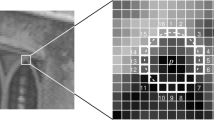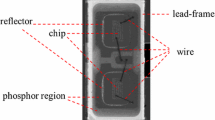Abstract
With the expansion in light-emitting diode (LED) lighting market and technology, control of product quality has become the focus of LED development. To achieve high online production capacity, automated quality detection with object image has been employed for comparison using mostly the standard templates. However, the resulting poor fitting causes misjudgment of the detection system. This study proposes an adaptive template method to improve the system fitting, reduce the system misjudgment, and enhance the detection efficiency. The severely damaged LED chips were screened out based on their grayscale entropy indices and related coefficient indices, which enhanced the reliability of the adaptive template system and accelerated the overall system detection process. To overcome the displacement and scale changes of the lithographic patterns, the scale-invariant feature transform (SIFT) and Harris–Laplace methods were used for comparison. The scale-invariant feature transform (SIFT) and Harris–Laplace methods were used to search and compare the feature points of the chip patterns, with the aim to overcome the displacement and scale changes of the lithographic patterns and establish the adaptive template in real conditions. The fast correlation coefficient comparison method was compared with the adaptive template comparison method proposed in this study. The results showed that the detection accuracy of the new method was 98.36%, which is 15.79% more accurate than the fast correlation coefficient comparison method. In terms of time performance, the method proposed in this study took 0.08 s less to complete the partition defect template. Moreover, the average detection time per chip was reduced by another 1.4 s, which improved the efficiency by 30.43%. The adaptive template proposed in this study exclusively establish itself based on different lithographic patterns, thus improving the detection efficiency and accuracy of the LED industry, and raising its market competitiveness in the industry.








































Similar content being viewed by others
Data availability
All data sets generated in this study are available from the corresponding author upon reasonable request.
References
Lin H, Li B, Wang X, Shu Y, Niu S (2019) Automated defect inspection of LED chip using deep convolutional neural network. J Intell Manuf 30(6):2525–2534. https://doi.org/10.1007/s10845-018-1415-x
Matsushita Y, Azuno T, Yamashita Y (2012) Fuel reduction in coastal squid jigging boats equipped with various combinations of conventional metal halide lamps and low-energy LED panels. Fish Res 125:14–19. https://doi.org/10.1016/j.fishres.2012.02.004
Kuo CFJ, Hsu CTM, Liu ZX, Wu (2014) HC Automatic inspection system of LED chip using two-stages back-propagation neural network. J Intell Manuf 25(6):1235–1243. https://doi.org/10.1007/s10845-012-0725-7
Eckstein HC, Zeitner UD, Leitel R, Stumpf M, Schleicher P, Bräuer A, Tünnermann A (2016) High dynamic grayscale lithography with an LED-based micro-image stepper. In: Optical Microlithography XXIX International Society for Optics and Photonics, p 9780 97800T. https://doi.org/10.1117/12.2219099
Choi JW, MacDonald E, Wicker R (2010) Multi-material microstereolithography. Int J Adv Manuf Technol 49(5-8):543–551. https://doi.org/10.1007/s00170-009-2434-8
Peng X, Bennamoun M, Ma Q, Lei Y, Zhang Q, Chen W (2010) Drift-correcting template update strategy for precision feature point tracking. Image Vis Comput 28(8):1280–1292. https://doi.org/10.1016/j.imavis.2010.01.007
Ravishankar (1996) AR Future directions in industrial machine vision: a case study of semiconductor manufacturing applications. Image Vis Comput 14(1):3–19. https://doi.org/10.1016/0262-8856(95)01035-1
Xiao J, Wei H (2014) Scale-invariant contour segment context in object detection. Image Vis Comput 32(12):1055–1066. https://doi.org/10.1016/j.imavis.2014.08.013
Xie J, Pun CM, Pan Z, Gao H, Wang B (2019) Automatic medical image registration based on an integrated method combining feature and area information. Neural Process Lett 49(1):263–284. https://doi.org/10.1007/s11063-018-9808-6
Wu WY, Hung CW, Yu WB (2013) The development of automated solder bump inspection using machine vision techniques. Int J Adv Manuf Technol 69(1-4):509–523. https://doi.org/10.1007/s00170-013-4994-x
Kuo CH, Yang FC, Wing JJ, Yang CK (2006) Construction of 3D solder paste surfaces using multi-projection images. Int J Adv Manuf Technol 31(5-6):509–519
Shi P, Qi Q, Qin Y, Scott PJ, Jiang X (2020) A novel learning-based feature recognition method using multiple sectional view representation. J Intell Manuf 31:1291–1309. https://doi.org/10.1007/s10845-020-01533-w
Fröhlich HB, Grozmani N, Wolfschlaeger D, Goncalves AA, Schmitt RH (2020) Construction of small sets of reference images for feature descriptors fitting and their use in the multiclassification of parts in industry. Int J Adv Manuf Technol 108:105–116. https://doi.org/10.1007/s00170-020-05253-6
Qin A, Guo L, You Z, Gao H, Wu X, Xiang S (2020) Research on automatic monitoring method of face milling cutter wear based on dynamic image sequence. Int J Adv Manuf Technol 110(11):3365–3376. https://doi.org/10.1007/s00170-020-05955-x
Yoo JC, Han TH (2009) Fast normalized cross-correlation. Circuits Syst Signal Process 28(6):819–843. https://doi.org/10.1007/s00034-009-9130-7
Li H, Lee WS, Wang K (2016) Immature green citrus fruit detection and counting based on fast normalized cross correlation (FNCC) using natural outdoor colour images. Precis Agric 17(6):678–697. https://doi.org/10.1007/s11119-016-9443-z
Kuo CFJ, Tsai CH, Wang WR, Wu HC (2019) Automatic marking point positioning of printed circuit boards based on template matching technique. J Intell Manuf 30(2):671–685. https://doi.org/10.1007/s10845-016-1274-2
Stefano DL, Marchionni M, Mattoccia S (2004) A fast area-based stereo matching algorithm. Image Vis Comput 22(12):983–1005. https://doi.org/10.1016/j.imavis.2004.03.009
Wang Z, Gong S, Li D, Lu H (2017) Error analysis and improved calibration algorithm for LED chip localization system based on visual feedback. Int J Adv Manuf Technol 92(9-12):3197–3206. https://doi.org/10.1007/s00170-017-0390-2
Perng DB, Liu HW, Chang CC (2011) Automated SMD LED inspection using machine vision. Int J Adv Manuf Technol 57(9-12):1065–1077. https://doi.org/10.1007/s00170-011-3338-y
Wang L, Chen B, Xu P, Ren H, Fang X, Wan S (2020) Geometry consistency aware confidence evaluation for feature matching. Image Vis Comput 103:103984. https://doi.org/10.1016/j.imavis.2020.103984
Wang XY, Hou LM, Wu J (2008) A feature-based robust digital image watermarking against geometric attacks. Image Vis Comput 26(7):980–989. https://doi.org/10.1016/j.imavis.2007.10.014
Harris CG, Stephens M (1988) A combined corner and edge detector. In Alvey Vis Conf 15(50):10–5244. https://doi.org/10.5244/C.2.23
Leutenegger S, Lynen S, Bosse M, Siegwart R, Furgale P (2015) Keyframe-based visual–inertial odometry using nonlinear optimization. Int J Robot Res 34(3):314–334. https://doi.org/10.1177/0278364914554813
Lowry S, Sünderhauf N, Newman P, Leonard JJ, Cox D, Corke P, Milford MJ (2015) Visual place recognition: A survey. Int J Robot Res 32(1):1–19. https://doi.org/10.1109/TRO.2015.2496823
Smith SM, Brady JM (1997) SUSAN—a new approach to low level image processing. Int J Comput Vis 23(1):45–78. https://doi.org/10.1023/A:1007963824710
Chen LC, Papandreou G, Kokkinos I, Murphy K, Yuille AL (2017) Deeplab: Semantic image segmentation with deep convolutional nets, atrous convolution, and fully connected crfs. IEEE Trans Pattern Anal 40(4):834–848. https://doi.org/10.1109/TPAMI.2017.2699184
Zhong F, He S, Li B (2017) Blob analyzation-based template matching algorithm for LED chip localization. Int J Adv Manuf Technol 93(1-4):55–63. https://doi.org/10.1007/s00170-015-7638-5
Yan Z, Shi B, Sun L, Xiao J (2020) Surface defect detection of aluminum alloy welds with 3D depth image and 2D gray image. Int J Adv Manuf Technol 110(3):741–752. https://doi.org/10.1007/s00170-020-05882-x
Lowe DG (1999) Object recognition from local scale-invariant features. In: Proceedings of the seventh IEEE international conference on computer vision, vol 2, pp 1150–1157. https://doi.org/10.1109/ICCV.1999.790410
Schmidhuber J (2015) Deep learning in neural networks: an overview. Neural Netw 61:85–117. https://doi.org/10.1016/j.neunet.2014.09.003
Sullivan GD, Baker KD, Anderson JADW (1985) Use of multiple difference-of-Gaussian filters to verify geometric models. Image Vis Comput 3(4):192–197. https://doi.org/10.1016/0262-8856(85)90007-1
Se S, Lowe DG, Little JJ (2005) Vision-based global localization and mapping for mobile robots. IEEE Trans Robot 21(3):364–375. https://doi.org/10.1109/TRO.2004.839228
Mikolajczyk K, Schmid C (2001) Indexing based on scale invariant interest points. In: Proceedings Eighth IEEE International Conference on Computer Vision ICCV, vol 1, pp 525–531. https://doi.org/10.1109/ICCV.2001.937561
Dorkó G, Schmid C (2003) Selection of scale-invariant parts for object class recognition. ICCV 3:634. https://doi.org/10.1109/ICCV.2003.1238407
Mikolajczyk K, Schmid C (2004) Scale & affine invariant interest point detectors. Int J Comput Vis 60(1):63–86. https://doi.org/10.1023/B:VISI.0000027790.02288.f2
Gordo A, Almazán J, Revaud J, Larlus D (2016) Deep image retrieval: learning global representations for image search. In: European conference on computer vision, pp 241–257. https://doi.org/10.1007/978-3-319-46466-4_15
Korytkowski M, Rutkowski L, Scherer R (2016) Fast image classification by boosting fuzzy classifiers. Inf Sci 327:175–182. https://doi.org/10.1016/j.ins.2015.08.030
Zhang J, Chen Q, Sun Q, Sun H, Xia D (2011) A highly repeatable feature detector: improved Harris–Laplace. Multimed Tools Appl 52(1):175–186. https://doi.org/10.1007/s11042-010-0471-9
Fawcett T (2006) An introduction to ROC analysis. Pattern Recogn Lett 27(8):861–874. https://doi.org/10.1016/j.patrec.2005.10.010
Chen D, Wang P, Yue L, Zhang Y, Jia T (2020) Anomaly detection in surveillance video based on bidirectional prediction. Image Vision Comut 98:103915. https://doi.org/10.1016/j.imavis.2020.103915
Mason SE, Nicolay CR, Darzi (2015) A The use of lean and six sigma methodologies in surgery: a systematic review. Surgeon 13(2):91–100. https://doi.org/10.1016/j.surge.2014.08.002
Kwak YH, Anbari FT (2006) Benefits, obstacles, and future of six sigma approach. Technovation 26(5-6):708–715. https://doi.org/10.1016/j.technovation.2004.10.003
Funding
The research was supported by the Ministry of Science and Technology of the Republic of China under Grant No. 109-2221-E-011-149.
Author information
Authors and Affiliations
Contributions
Conceptualization, Chung-Feng Jeffrey Kuo; methodology, Cheng-Yu Hung and Wei-Han Weng; validation, Chen-Yang Tsa and Cheng-Yu Hung; formal analysis, Chung-Feng Jeffrey Kuo and Chen-Yang Tsa; data interpretation, Wei-Han Weng and Cheng-Yu Hung; writing—original draft preparation, Cheng-Yu Hung; writing—review and editing, Chung-Feng Jeffrey Kuo; visualization, Chen-Yang Tsai; funding acquisition, Chung-Feng Jeffrey Kuo.
All authors have read and agreed to the published version of the manuscript.
Corresponding author
Ethics declarations
Ethics approval and consent to participate
Not applicable.
Consent for publication
Not applicable.
Competing interests
The authors declare no competing interests.
Additional information
Publisher’s note
Springer Nature remains neutral with regard to jurisdictional claims in published maps and institutional affiliations.
Rights and permissions
About this article
Cite this article
Weng, WH., Tsai, CY., Hung, CY. et al. Development of an adaptive template for fast detection of lithographic patterns of light-emitting diode chips. Int J Adv Manuf Technol 117, 3297–3321 (2021). https://doi.org/10.1007/s00170-021-07774-0
Received:
Accepted:
Published:
Issue Date:
DOI: https://doi.org/10.1007/s00170-021-07774-0




